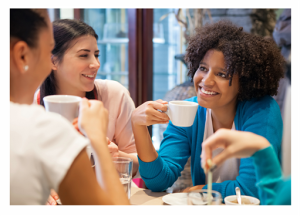Fresh air, albeit damp. Movement, as in a car. People – with all their sounds and smells, their shapes and sizes, their low murmurs to themselves and chatty conversations with children and friends.
And oh, the colors… Reds and blues and purples of magazines on racks, brightly patterned scarves dangling from orange and gray jackets, women in lipstick in pretty shades…
How long had it been since I was out for more than the barest necessities?
Too long. Much too long.
Have I become a literal virtual shut-in? Am I headed in that direction? Are you?
Are You a Social Media or Work-Life Shut-In?
When the fridge and pantry were nearly empty – I had been living on toast and coffee for four days – I ran out to buy food. That was four days ago. It was great to be out, but I was single-minded in my focus and returned directly to the activities at hand. Namely, a work project.
There have been other times when I could have left the house, but it was so much easier to stay in and “engage” via social media. I could easily feel a part of something by chatting on Twitter or Facebook or through email. Social media, it seems to me, can encourage certain “shut-in” behaviors – if we’re not careful.
This morning, it was clear that once again I was down to nothing when it comes to key areas that help us run our lives. Errands were in order – pharmacy, bank, post office, supermarket. To get to the pharmacy, I walk through a coffee shop and a bookstore.
Aromas! Voices! Then all those glorious shelves of color and words stretching out in front of me – striking after so many days at my computers (yes, plural), and delicious – even if only in passing. There was the round man with stubble and a smile, in his cherry red zip-up jacket. Energizing! There was the woman with the violet-streaked hair (yes, violet). Delightful!
What We Miss by Not Getting Out
Don’t even get me started on the periodicals and books trying to tempt me to stop – flirtatious devils – though I continued on my way to the pharmacy, to pick up what had been waiting for days and days…
I think of all I have missed by not getting out, by being so immersed in a project with an aggressive deadline that I have hardly seen anyone or gone anywhere in weeks. I have missed the energy of visual stimulation and movement, the creativity that is jacked up as a result, the sense of being part of the world that lifts my spirits.
I feel as though I have become a shut-in these past weeks, and I genuinely wonder if I possess the makings of a shut-in personality. After all, I enjoy my solitude, and my professional life requires a fair amount of it. But too much alone time becomes isolating, disconnecting, and just plain dull.
 How many of us are so glued to our gadgets (and work schedules) that we’re becoming virtual shut-ins?
How many of us are so glued to our gadgets (and work schedules) that we’re becoming virtual shut-ins?
What Makes a Person a Shut-In?
The question of who or what is a “shut-in” is an interesting one. I suspect that slowly closing down one’s world – especially if you suffer from social anxiety – is both exacerbated and in a way helped by our Internet connections.
As for the narrowing of one’s real world community, I imagine it is a bit easier to slip into as we mature. For example, when children’s schedules no longer require us to chauffeur them here and there, if we don’t have spouses expecting us to cook dinner (or sit down and eat with them when they’ve prepared it), if we feel connected via the internet – and we’re tired from our jobs, which may well play out on the very same worldwide web – why leave the house?
Yet aren’t we then vulnerable to losing our connections to the outside world? Those “real life” connections that include voice, sound, sight, smell and always important – touch?
Sure, we can communicate. We “see” each “hear” each other on our smartphones and iPads and laptops. But it isn’t the same and we know it isn’t the same. Then again, just because some of us spend gobs of solo time, with or without or digital dialogs, that doesn’t necessarily mean we’re lonely. Isolated, perhaps. But lonely? That’s another matter.
How Many Shut-ins Are There in the US?
Incidentally, I was curious about the number of “shut-ins” there may be in the US. I tried to locate an estimate, and apparently it’s not so simple to find.
According to an article in the New York Times Magazine (a bit dated, but interesting), some are reclusive from a very early age, clearly suffering from social-psychological issues that need to be dealt with. That, too, is another matter.
I tend to think of the “classic” shut-in as an older person, cut off from social contact by virtue of being left alone by family, no longer part of the workforce, possibly suffering anxiety issues and feeling more comfortable in an undisturbed environment.
I remain curious about adult shut-ins and their numbers, and whether the ranks of the reclusive are on the rise. What I was able to find was the estimated number of Americans who suffer social anxiety disorders of some sort. That figure is 40 million. Think about that!
How many of those are shut-ins?
Hard to say. Hundreds of thousands? A few million? Is it some fraction of the 6 million who explicitly suffer panic disorder?
Work Life Balance: People Need People
 How many of us are losing social skills and our humanity as person-to-person interaction dwindles, whatever the causes?
How many of us are losing social skills and our humanity as person-to-person interaction dwindles, whatever the causes?
Do our increasingly isolated working conditions amp up the likelihood of being a shut-in? Are we left, like me, forgetting to “get out,” ignoring the importance of sensory experiences that enable us to more fully comprehend what it means to be human? Are we becoming a culture of quasi-shut-ins?
I feel as though I ought to belt out a quick refrain of “People Who Need People” à la Streisand.
I need people in my life. Real people. More often. I need to get out. More often.
How about you?
You May Also Enjoy

Oh, thank you so much for writing about this. The topic has been weighing heavily on my mind, and lately it’s been a central point of therapy-type discussion with my husband. We have all sorts of names for what I feel I am becoming: hermit, hikkikomori (Japanese term for someone who alienates herself from society (it could be another name for depression, actually))….
For me it’s connected to a web of causes: anxiety, complacency, technology, isolation, and the fact that I work from home. I’m comfortable in this position and yet it doesn’t always feel good. I want to get out of it but am not sure where to begin.
I am an introvert, and I have always needed to spend time alone to recharge my batteries. Now that I am older I am more comfortable with acknowledging that fact. I often thought there was something wrong with me. It’s not that I dislike people, I simply prefer them in small doses. The internet does make it easy to indulge in my need to be alone. Could never do with simply toast and coffee, though. Love to cook and eat… Grocery shopping has always been a favorite past time.
You are a wonderful writer, D. A., and I do not say it often enough.
‘People in small doses.’ I like the way you phrased that, Cornelia. And thank you for the good words.
I know when I’ve reached my fill of either. Generally, too much socializing wears me down quicker than solitude. I enjoy both so much – and have learned to listen to myself when it’s crying for either.
I need a balance of solitude and social interaction. Interaction may mean just getting out for a walk, sitting in the park, or watching young kids play. Social interactions helps improve my quality of life and solitude helps me reflect on these experiences.
Yes! I had a moment yesterday while walking the dogs where I thought, “Wow, look at all these people! Going about their business! Working!” and I realized that I am really grateful that the dogs force me to get out of the house…but it is still not often enough. As someone who is quite shy by nature, I am more with Cornelia’s idea of “small doses” but also find that I am much more sociable when I am in my “home culture” when I visit the States…
Since I write and coach clients from home, I understand first-hand what it’s like to experience cabin fever. When I added in a part-time office job last Spring, I discovered that even though the pay is low, just getting out of the house three times per week where I’m around others has been beneficial to my emotional well-being.